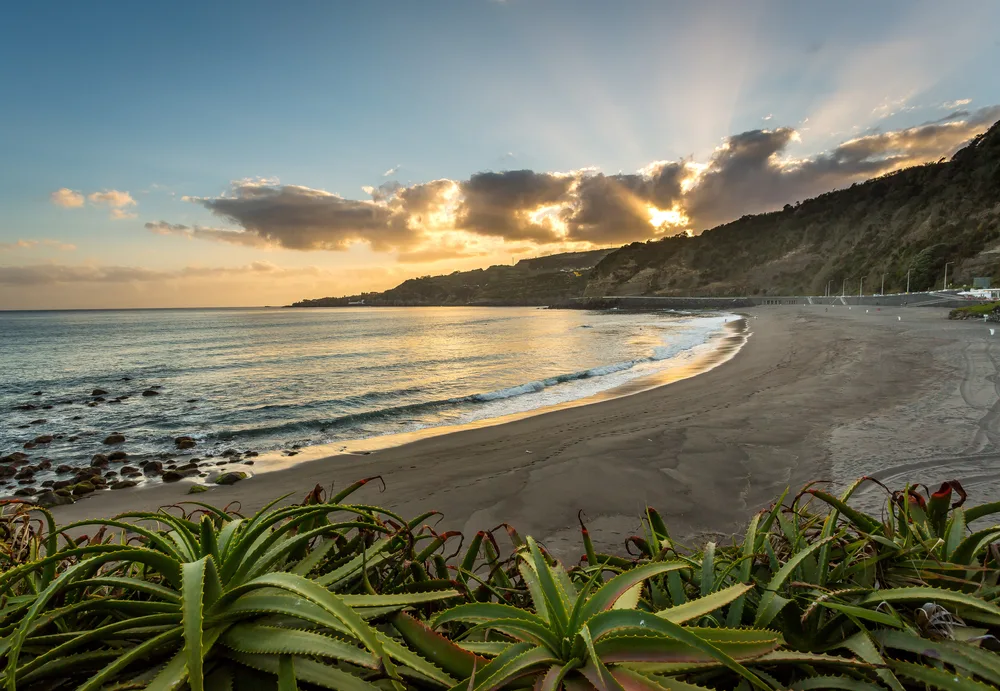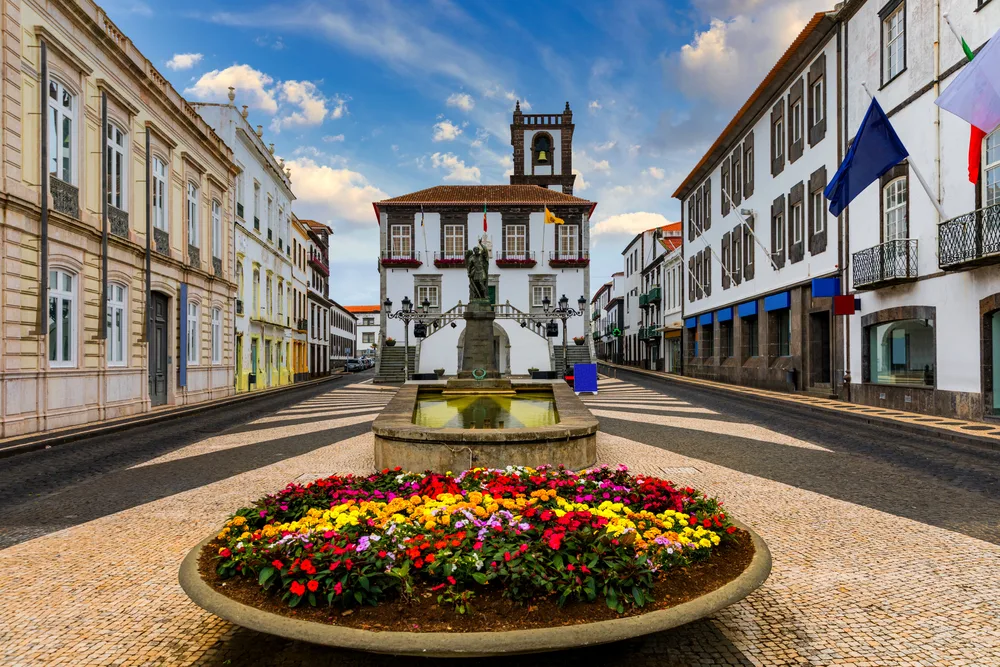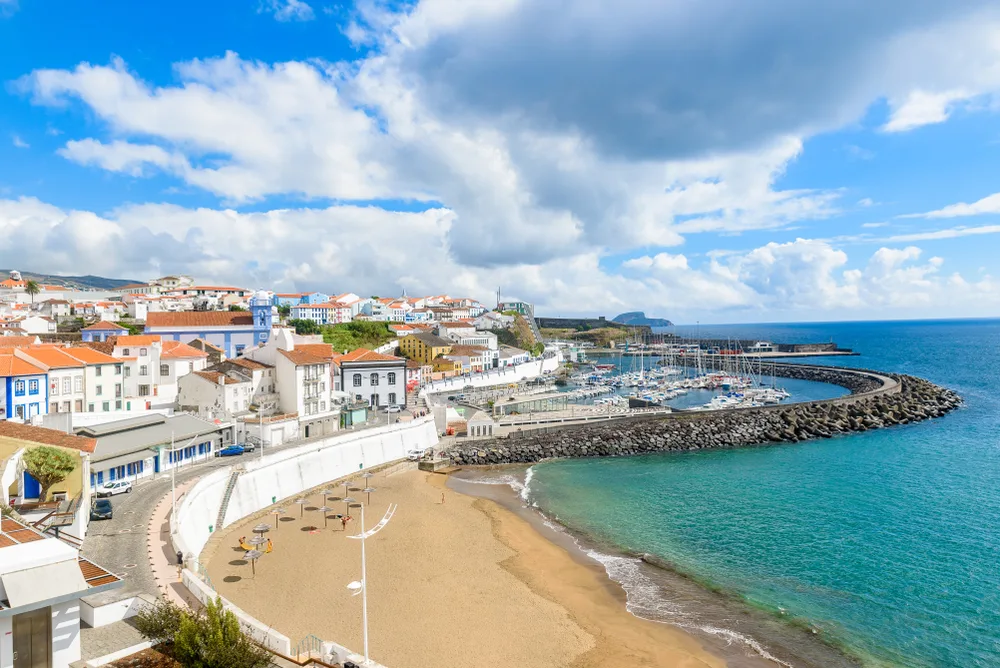What's the best time to visit the Azores?
The best time to visit the Azores is during the summer, with its subtropical climate providing clear skies and warm temperatures in the mid-high 70s. This season offers the best conditions for outdoor activities, swimming, and marine adventures due to calmer seas.
Summer also brings local festivals like San Joaninas, Walk&Talk, and Mare de Agosto, though it also means higher visitor numbers and prices. Despite the generally unpredictable weather, summer affords the highest chance of sunny days.
The dramatic islands of the Azores are part of Portugal, but nestled in the Atlantic Ocean, they feel far away from any other place on Earth. Nature lovers flock to the Azores to take in the beautiful volcanic landscapes, which you can explore by hiking landmarks such as Mount Pico or Sete Cidades.
The islands are a perfect destination for water sports as well, from surfing to diving with dolphins. For a more laid-back adventure, soak in one of the thermal springs, taste the wine that grows on the volcanic hills, or visit the quaint towns.
Thanks to their natural beauty and the growing tourist infrastructure, including high-end resorts, the Azores are fast becoming popular among visitors. Keep reading to know about the best time to time your own visit.
The Overall Best Time to Visit the Azores

Tim de Waardt/Shutterstock
The best time to visit the Azores is during the summer, when you have a higher chance of experiencing clear skies and hotter temperatures. The unique landscape and location of the Azores shapes their climate.
They are classified as a subtropical location, meaning that the climate is warm and wet. The islands are located along the Gulf Stream, which means that the climate is mild all year round.
Temperatures in the capital, Ponta Delgada, are warmest in July, August, and September, hovering in the mid-high 70s. Even in the winter, it doesn’t get too cold. Only on the coldest nights do temperatures dip below 50 degrees.
However, the same location that keeps the temperature warm affects precipitation on the archipelago. Since the islands are located right in the middle of the Atlantic Ocean, the weather is unpredictable, with frequent rain.
Visiting in the summer gives you the highest chance of clear, sunny days as the rest of the year is quite cloudy, but you should prepare for rain storms anyway.
To make the most of a visit to the Azores, you really want to have good weather. After all, hiking to the top of Mount Pico just to have the view covered by clouds would be really disappointing!
In the summer, cloud cover is the least frequent it is all year, meaning that you will likely have the best conditions for hiking, taking photos, and admiring the sunsets. Summer also means that you get to enjoy one of the benefits of visiting an island—heading to the beach.
The temperature warms up for swimming (although the ocean is always chilly) and you can also go diving or swim with marine animals. Locals also enjoy swimming in the swimming holes and waterfalls that dot the interior of the island.
Another benefit of the calmer weather is that the sea is not as choppy as it is during the rest of the year. If you were hoping to take a boat to the Azores, go on a whale-watching tour, or go on a fishing or sailing expedition, the best conditions to do so happen during the warmer months.
Summer is the liveliest season in the Azores, which depending on your perspective, may be a good or bad thing. The islands receive many visitors in the summer, meaning that prices and crowding goes up. However, that also means that summer has a higher chance of everything being open.
Plus, summer is when you’ll encounter the most local festivals, such as:
- San Joaninas, the feast day of Sao Joao (June)
- Walk&Talk, a street art festival (July)
- Mare de Agosto, a music festival highlighting mostly Portuguese music (August)
Cheapest Time to Visit the Azores

Paulo Miguel Costa/Shutterstock
The cheapest time to visit the Azores is during the winter, between November and March, when prices are deeply discounted during the island’s low season.
Winters in the Azores are mild, with temperatures rarely getting even close to freezing. However, this is the rainiest season, with very frequent showers. For that reason, winter is the low season in the Azores.
One of the biggest costs when visiting the Azores is actually getting there, but the cost of getting there dramatically decreases during the winter. Ferry schedules decrease, but the remaining departure times are usually more affordable than in the summer.
Airfare also decreases drastically during the winter. The price of flights to the Azores decreases during this season, sometimes by hundreds of euros. Although the frequency of direct flights to the islands decreases, with most destinations requiring a stopover in mainland Portugal, the discounts are worth the extra stop.
Hotels, resorts, and other accommodation also offer steep discounts to winter visitors. Save up to 25% on your accommodation, and if you’re lucky, you may even snag a deal at a high-end resort.
Least Busy Time to Visit the Azores

DaLiu/Shutterstock
The least busy time to visit the Azores is in the spring (April-May) or fall (September-October), which are the shoulder seasons. This period is great for whale-watching, something the Azores is famoous for.
Baleen whales migrate between April and June, allowing you to spot species that aren’t visible around the islands during the rest of the year. The most important traditional festivals, many of them connected to Catholicism, happen during the spring, allowing you to get a glimpse of local culture.
Besides Easter and Holy Week, important throughout the Iberian Peninsula, the Azores celebrate the Festas do Divino Espirito Santo in late spring with weeks of parades.
In the fall, the timing is perfect for hiking. The return of the rains means that the landscapes are lush and green, although you will need to bring waterproof gear on your hikes. Plus, you won’t have to share the trails with other visitors.
Late summer and early fall are actually the best times to visit for some water sports as the wind picks up. Surfing and windsurfing all pick up in September, and professional competitions such as the Azores Pro surfing competition happen in the autumn.
Worst Time to Visit the Azores

Mitroshenkov Ilia/Shutterstock
The worst time to visit the Azores is during the winter, between November and March, when the weather makes it difficult to do much exploring.
Don’t underestimate the power of the Azores rain. Between November and March, every day brings a 30% chance of rain and 60% chance of cloud coverage. Most days see some showers, with the weather sometimes changing in minutes.
A persistent fog hangs over the island, making the atmosphere gray and blocking the views. Temperatures are mild, but chillier than in the summer. The Azores also wind down during this time.
Flight and ferry schedules decrease in frequency, giving you fewer transportation options. Many tourism-oriented businesses, such as whale-watching tours, shut down for the season.
However, if you bring the right gear and don’t mind getting a little wet, you can still make the most of your trip during the winter. You can still visit wineries or tea plantations and go on short hikes, just bring waterproof shoes.
The weather may be too cold for swimming in the ocean, but thanks to the hot springs throughout the islands, you’ll still be able to take a dip. Plus, thanks to the deep discounts, you can get pampered at a resort for a fraction of the price you would pay in the summer.
Frequently Asked Questions

Loredana Habermann/Shutterstock
Still have questions about when to visit the Azores? These additional answers may help:
What is the best month to go to the Azores?
The best month to go to the Azores is June, when the weather is beautiful, the crowds are not fully at peak, and you can catch some of the local festivals.
When is the Azores rainy season?
The Azores get the most rain between October and March, but it rains a lot throughout the year on the archipelago.
What is the least expensive month to go to the Azores?
January is the least expensive month to visit the Azores, and you can find deep discounts on flights and accommodation.
So, What’s the Best Time to Visit the Azores?
The best time to visit the Azores is during the summer, between June and late August. The weather is at its best (although there is still a chance of rain), meaning you can hike and swim to your heart’s content.



